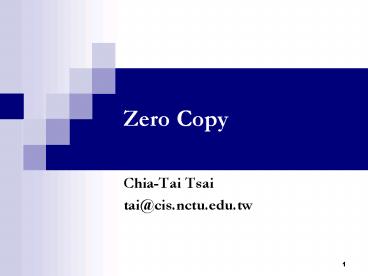Zero Copy - PowerPoint PPT Presentation
1 / 17
Title: Zero Copy
1
Zero Copy
- Chia-Tai Tsai
- tai_at_cis.nctu.edu.tw
2
Introduction
- Data copy and Checksum overhead dominates
processing time for high throughput application
in networking software. - Single-Copy (CPU copy)
- Single-copy and checksum overhead still accounts
for 60 of networking software overhead. - Zero-Copy
- Moving data between application domains and
network interfaces without CPU intervention
3
Where do copies occur?
Sender
Receiver
Move data from application to system buffer
Move data fromsystem buffer toapplication
COPY
OVERHEAD
TCP/IP Protocol
TCP/IP Protocol
Compare Checksum
Compare Checksum
Network Driver
Network Driver
Transmit packet tonetwork interface
Deposit packet in host memory
4
General Operating System Structure and Data Path
user space kernel space
5
Example
- Thus, copy operations is expensive
- bandwidth is limited
- consumes CPU cycles
- affects the cache
Notethese transfers only show data movement
between sub-systems. Additionally, data touching
operations within a sub-system will require that
data is moved from memory and to the CPU, e.g.
- checksum calculation - encryption - data
encoding - forward error correction
Pentium 4 Processor
registers
cache(s)
RDRAM
RDRAM
RDRAM
RDRAM
PCI slots
PCI slots
PCI slots
6
To Eliminate Copies
- Main idea Pass data by reference all the way
down through the protocol stack - We need
- Advanced Network devices scatter/gather DMA
- Modification of OS kernel
7
Zero-Copy Basic Idea
mbuf
buf
b_data
m_data
bus(es)
8
Zero-Copy Dynamic Allocation
user space memory
application
mbuf memory pools
buf memory pools
file system
communication system
mbuf
buf
mbuf cluster
buf cluster
9
Zero-Copy Static Allocation
header
data pointer
mbuf pointer
buf pointer
bufs
- Allocate all needed memory during stream
initialization - If possible, set all buf and mbuf data pointers
- Use alternating buffers
mbufs
dataarea
10
Zero-Copy Operations
currently used buffer
currently used buffer
header
header
send offset
send offset
bufs
bufs
- Stream initialization
- Read operation
- Send operation
- Stream close
mbufs
mbufs
dataarea
dataarea
11
Zero Copy Schemes
- User accessible interface memory
- Kernel-network shared memory
- User-kernel shared memory
- User-kernel page remapping COW(copy-on-write)
12
User accessible interface memory
- The network interface memory is accessible and
pre-mapped into user and kernel address space. - Cons
- Requires complicated hardware support, software
changes - On receive side, it requires intelligence in the
network hardware to direct incoming data to the
right interface memory pool. - Application is required to use special buffer
management calls to allocate and use the
interface memory. - Limited interface memory could pose a serious
resource problem.
13
Kernel-network shared memory
- OS kernel manage the interface memory and uses
DMA or PIO(program I/O) to move data between
interface memory and application buffer. - Not require application to be modified
- Cons
- Kernel code change manages special pool of
memory from network interface.
14
User-kernel shared memory
- Defines a new set of APIs with shared semantics
between the user and kernel address spaces. - Uses DMA to move data between the shared memory
and the network interface. - Fast Buffers
- it uses a per-process buffer pool that is
pre-mapped in both the user and kernel address
spaces. - Cons
- No compatibility because of new APIs
- Network hardware must be capable of targeting DMA
transfer of an incoming packet to the correct
memory pool allocated by client.
15
User-kernel shared memory
16
User-kernel page remapping COW
- Uses DMA to transfer data between interface
memory and kernel buffers, and remaps buffers by
editing the MMU (Memory Management Unit ) table
to give the appearance of data transfer. (with
copy-on-write) - No modification in socket interface and VM system
- Cons
- All the buffers involved must align on page
boundaries and occupy an integral number of MMU
page - problem in larger MTU size than system page
size. - Network drivers must arrange receive buffers on a
page boundary. - need to predict header size
- Application should avoid reusing busy buffers.
17
Conclusions
- Efficient zero-copy implementation for network
I/O. - Design based on virtual memory page remapping and
copy-on-write require the least amount of
changes.








![[PDF READ ONLINE] Zero to One: Notes on Startups, or How to Build the Future PowerPoint PPT Presentation](https://s3.amazonaws.com/images.powershow.com/10090454.th0.jpg?_=20240802025)
![[PDF]DOWNLOAD Zero to One: Notes on Startups, or How to Build the Future PowerPoint PPT Presentation](https://s3.amazonaws.com/images.powershow.com/10090455.th0.jpg?_=20240802024)

![[PDF READ ONLINE] Zero to One: Notes on Startups, or How to Build the Future PowerPoint PPT Presentation](https://s3.amazonaws.com/images.powershow.com/10094810.th0.jpg?_=20240809026)
![[PDF]DOWNLOAD Zero to One: Notes on Startups, or How to Build the Future PowerPoint PPT Presentation](https://s3.amazonaws.com/images.powershow.com/10094811.th0.jpg?_=20240809026)
![[READ DOWNLOAD] Zero To One PowerPoint PPT Presentation](https://s3.amazonaws.com/images.powershow.com/10094822.th0.jpg?_=20240809029)


![get [PDF] Download Zero To One PowerPoint PPT Presentation](https://s3.amazonaws.com/images.powershow.com/10096724.th0.jpg?_=20240812122)




![Download Sixty to Zero: An Inside Look at the Collapse of General Motors--and the [PDF] PowerPoint PPT Presentation](https://s3.amazonaws.com/images.powershow.com/10112969.th0.jpg?_=202408300912)
![[PDF READ ONLINE] Zero to One: Notes on Startups, or How to Build the Future PowerPoint PPT Presentation](https://s3.amazonaws.com/images.powershow.com/10114335.th0.jpg?_=202408310812)
![[PDF]DOWNLOAD Zero to One: Notes on Startups, or How to Build the Future PowerPoint PPT Presentation](https://s3.amazonaws.com/images.powershow.com/10114336.th0.jpg?_=202408310812)

![DOWNLOAD/PDF The Power of Zero, Revised and Updated: How to Get to the 0% Tax Bracket and [PDF] PowerPoint PPT Presentation](https://s3.amazonaws.com/images.powershow.com/10114646.th0.jpg?_=20240831018)
![[PDF READ ONLINE] Zero to One: Notes on Startups, or How to Build the Future PowerPoint PPT Presentation](https://s3.amazonaws.com/images.powershow.com/10115815.th0.jpg?_=202409010710)
![[PDF]DOWNLOAD Zero to One: Notes on Startups, or How to Build the Future PowerPoint PPT Presentation](https://s3.amazonaws.com/images.powershow.com/10115816.th0.jpg?_=202409010710)

![[READ DOWNLOAD] Zero To One PowerPoint PPT Presentation](https://s3.amazonaws.com/images.powershow.com/10115830.th0.jpg?_=202409010712)

